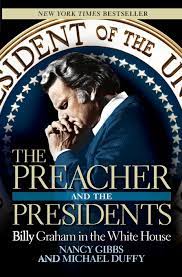
Nancy Gibbs & Michael Duffy
Recommendation: 4/5
Description of authors: Nancy Gibbs & Michael Duffy are both twenty-two-year veterans of TIME.
Comments: In this book, the authors trace Billy Graham’s involvement with the Presidents of the United States. The story begins with Graham’s 1949 Los Angeles crusade. It was during this crusade that he gained nation wide attention. The authors explain what happened: One night Graham and his team arrived at the tent to be greeted by a herd of photographers and reporters. What on earth had happened? ‘You’ve just been kissed by William Randolph Hearst,’ one newsman explained . . . The Hearst papers began running stories about the crusade all across the country, and it was not long before other news organizations noticed. By the final week of the crusade, all the wire services as well as LIFE, Newsweek, and the major papers were running stories (p.6).
All of a sudden Graham was a celebrity, being invited everywhere and being introduced to everyone. It was Massachusetts congressman John McCormack who first arranged for a meeting between Graham and the President (Harry Truman) in July 1950 (p. 16); Graham was just 31 years old. Although Graham and Truman never really hit it off, it marked the beginning of an incredible relationship between Billy Graham and the Presidents of the United States. Graham has had a friendship with every President since Truman and has been a regular and highly regarded guest at the White House throughout that time. He was closest, it would seem, to Nixon, Reagan, the Bush family, and Clinton. From a historical and political perspective, this is a truly fascinating book. Graham had impressive political influence and was regularly consulted in regard to political moves and public opinion. The Presidents used Graham for anything from forwarding the civil rights agenda (p. 134 ff) to giving messages to the North Korean government (p. 312 ff). Perhaps one of the most interesting parts of the book is the description of how George Bush senior purposely studied how to court evangelical voters, including how to answer the question of whether or not he was ‘born again’ (p. 284 ff). Regardless of one’s opinion of Billy Graham as a voice for evangelicalism, this is a book well worth reading for anyone interested in history.